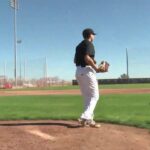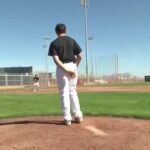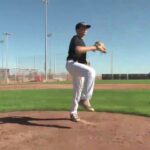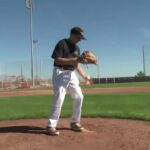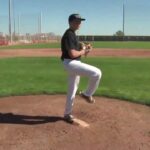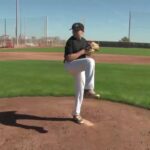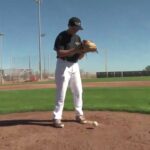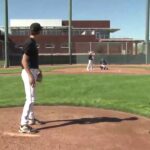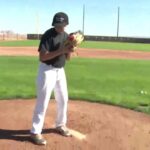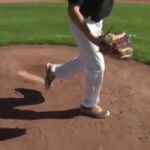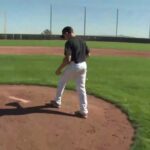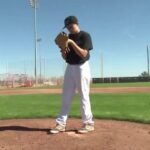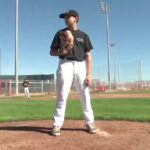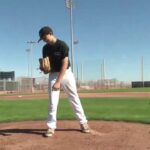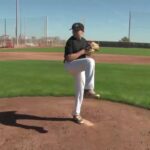Rule 6 – Section 1 – PITCHING
6-1-1 The pitcher shall pitch while facing the batter from either a windup position (6-1-2) or a set position (6-1-3). The position of his feet determine whether he will pitch from the windup or the set position. He shall take his sign from the catcher with his pivot foot in contact with the pitcher’s plate. The pitching regulations begin when he intentionally contacts the pitcher’s plate. Turning the shoulders to check runners while in contact with the pitcher’s plate in the set position is legal. Turning the shoulders after bringing the hands together during or after the stretch is a balk. He shall not make a quick-return pitch in an attempt to catch a batter off balance. The catcher shall have both feet in the catcher’s box at the time of the pitch. If a pitcher is ambidextrous, the umpire shall require the pitcher to face a batter as either a left-handed pitcher or right-handed pitcher, but not both.
6-1-2 For the wind-up position, the pitcher is not restricted as to how he shall hold the ball. A pitcher assumes the windup position when his hands are: (a) together in front of the body; (b) both hands are at his side; (c) either hand is in front of the body and the other hand is at his side. The pitcher’s non-pivot foot shall be in any position on or behind a line extending through the front edge of the pitcher’s plate. He is limited to not more than two pumps or rotations. After he starts his movement to pitch, he must continue the motion without interruption or alteration. With his feet in the wind-up position, the pitcher may only deliver a pitch or step backward off the pitcher’s plate with his pivot foot first. After the pitcher has placed his pivot foot clearly behind the plate, he has the right to change to the set position or throw or feint to a base the same as that of any infielder. During delivery, he may lift his non-pivot foot in a step forward, a step sideways, or in a step backward and a step forward, but he shall not otherwise lift either foot.
6-1-3 For the set position, the pitcher shall have the ball in either his gloved hand or his pitching hand. His pitching hand shall be down at his side or behind his back. Before starting his delivery, he shall stand with his entire non-pivot foot in front of a line extending through the front edge of the pitcher’s plate and with his pivot foot in contact with or directly in front of and parallel to the pitcher’s plate. He shall go to the set position without interruption and in one continuous motion. He shall come to a complete and discernible stop (a change of direction is not considered an acceptable stop) with the ball in both hands in front of the body and his glove at or below his chin. Natural preliminary motions such as only one stretch may be made. During these preliminary motions and during the set position until a delivery motion occurs, the pitcher may turn on his pivot foot or lift it in a jump turn to step with the non-pivot foot toward a base while throwing or feinting as outlined in 6-2-4 and 2-28-5, or he may lift his pivot foot in a step backward off the pitcher’s plate which must be in or partially within the 24-inch length of the pitcher’s plate. In order to change to the wind-up position, he must first step clearly backward off the pitcher’s plate with his pivot foot first. After the pitcher has placed his pivot foot on the ground clearly behind the plate, he then has the right to throw or feint to a base the same as that of any other infielder.
PENALTY (6-1-1, 6-1-2, 6-1-3): The ball is dead immediately when an illegal pitch occurs. If there is no runner, a ball is awarded the batter. If there is a runner, such illegal act is a balk. In both situations, the umpire signals dead ball.
6-1-4 Each legal pitch shall be declared by the umpire as a strike, ball, fair or foul hit or a dead ball. A pitch dropped during delivery and which crosses a foul line shall be called a ball. Otherwise, it will be called no pitch. A pitch dropped during delivery with at least one runner on base would be a balk if it does not cross a foul line.
6-1-5 When a pitcher is attempting to field a batted or thrown ball or is throwing to a base while his pivot foot is clearly off his plate, his status is that of an infielder except that if a batted ball passes but does not touch him and then strikes an umpire or a runner, the ball may become dead because of interference (8-4-2g, 8-4-2k).
6-1-6 Each state association shall have a pitching restriction policy based on the number of pitches thrown to afford pitchers a required rest period between pitching appearances.




